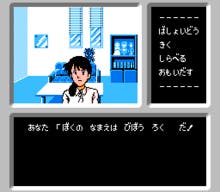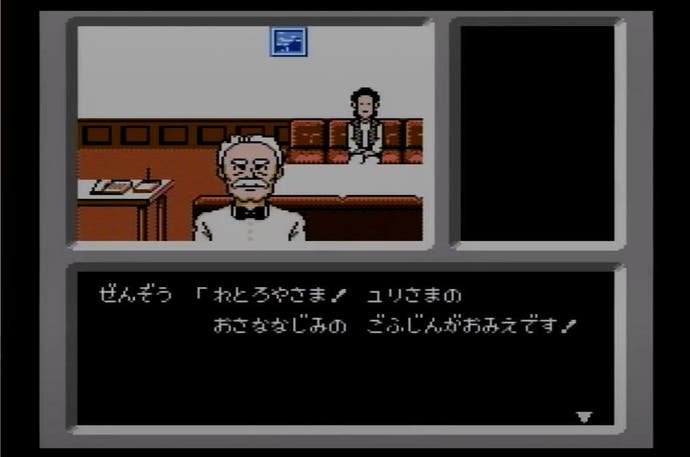Famicom Detective Club: the history behind Nintendo's once-forgotten foray into visual novels
Howdunnit
This week saw the re-release of a real Nintendo curio. The Famicon Detective Club games initially seem to have come from a parallel universe - Nintendo games, but also visual novels? The re-releases of the first two adventures have been lovingly handled, with beautifully updated graphics and plenty of quality-of-life changes, although be warned that they remain wilful and rather odd. To help make sense of where these games came from, though, we've decided to dig into the history of this fascinating series.
When you think about Nintendo in the 80s, what comes to mind? Super Mario Bros? Duck Hunt and the glorious NES Zapper? Absolute domination of the home console market? All valid answers, but even for Nintendo's most dedicated, Famicom Detective Club probably isn't topping your list. Released for the Famicom Disk System in 1988, these game brought us two classic murder mystery visual novels, something we've not seen from the Nintendo since Last Window. Sadly, this duology never launched outside Japan, though it holds an intriguing history.
You can picture the surprise then, when Nintendo announced Switch versions were on the way, and would finally arrive in the West too. Now, this isn't another case of translating the original versions as Earthbound Beginnings or Fire Emblem: Shadow Dragon And The Blade Of Light were. First confirmed in 2019, Steins;Gate developers Mages have given both entries the full remake treatment, retaining that core gameplay with brand-new graphics, music, and fully voiced dialogue.
So, you might be wondering, just what are these games about? Our story began in The Missing Heir, as our nameless protagonist wakes up by a cliff, suffering with amnesia. Eventually remembering he's an assistant detective, he teams up with Ayumi Tachibana, realising they're both investigating the murder of Kiku Ayashiro. Soon enough, the duo gets wrapped up in a legend surrounding the Ayashiro family's treasure, one that not only threatens to resurrect the deceased, but kill anyone who'd try stealing it.
Proving successful, the series got a prequel, released the following year, called The Girl Who Stands Behind. Set two years before The Missing Heir, we find our protagonist taken in after his parents disappeared, and trained by an investigator to become a detective himself. Tasked with looking into a murder at Ushimitsu High School, a place haunted by ghostly rumours for many years, the protagonist and Ayumi eventually discover connections to a much older murder case, one nearing its statute of limitations.

Though not especially original by today's standards, these stories set a high-quality standard, and that's attributable to Yoshio Sakamoto. These days, he's better known for working on Metroid and even the WarioWare games, but it's actually Famicom Detective Club that marked his first experience as a scenario writer. Just a novice at the time, Sakamoto was approached by Nintendo's legendary Gunpei Yokoi, the father of, amongst other things, the Game Boy. Acting as the game's producer, Yokoi asked Sakamoto to create an idea solely based around a working title, Famicom Shonen Tanteidan (Family Computer Youth Detective Group).
With nothing else to go on, Sakamoto got to work with Nintendo's R&D1 team, but things didn't have the smoothest start. The group wasn't prepared for a game in which story would have such a central role, so to help out, Sakamoto took a risk. Taking on the basic amnesia concept suggested by his wider team, he asked to become the game's scenario writer. Though he considers it a "reckless" move now, that ultimately became a career defining moment.
Rather than take inspiration from detective works - save for the novels of Seishi Yokomizo - Sakamoto primarily looked towards two places. One was The Portopia Serial Murder Case, an early effort by Dragon Quest creator Yuji Horii. The other was... more surprising. At 2010's GDC Sakamoto revealed that the Italian film director Dario Argento, famous for his horrors, was a major influence. Later citing Deep Red as a favourite film, Sakamoto later revealed that Argento's filmmaking approach continues inspiring his writing to this day. He follows four key tenets from the master: mood, timing, foreshadowing, and contrast.

Realising Famicom Detective Club's gameplay should be designed entirely around the story, Sakamoto ran with this new approach, eventually handing the team a handwritten copy of his planned scenario. With the groundwork set, everything else soon came together. As part of their investigations, players would explore various environments, talking with other characters to obtain information, whilst examining objects for further clues. It was a simple approach, but an effective one, and both games ultimately reviewed well, even if lasting fame eluded them.
The games weren't completely forgotten by Nintendo, but they weren't well supported, either. Nearly a decade later, The Girl Who Stands Behind received a Super Famicom (SNES) remake, featuring improved graphics, a revised soundtrack, and a new gameplay feature letting players review character information already gathered. However, upon release, the N64 was already two years old, and this remake was only made available via the Nintendo Power system, via a process involving rewritable flash cartridges. It's a format ill-designed for long-term storage - and was hardly mass-market - but that edition of the game survived, and later received a fan translation.

Even more obscurely, a third game was released in 1997 called "BS Tantei Club: Yuki ni Kieta Kako", which featured Ayumi investigating a murder to prove her mother's innocence. This game was broadcast across three chapters through the Super Famicom's satellite modem peripheral, the Satellaview, also introducing voice acting for Ayumi, but probably denying it any chance of a truly broad audience. Yuki ni Kieta Kako isn't currently getting a Switch remake - unsurprising given that Nintendo rarely acknowledges its Satellaview library ever existed.
Since then, though, we've really not seen much else of Famicom Detective Club. Ayumi appeared as a trophy in Super Smash Bros Melee - and was even considered by Masahiro Sakurai as a playable fighter - but re-releases aside, all we've had is an unlockable Ayumi costume in Super Mario Maker. Forgotten by all but hardcore fans, Nintendo's decision to remake these games is welcome, but also somewhat surreal, considering popular choices like F-Zero, Kid Icarus, and Golden Sun remain dormant for the time being.
With Sakamoto and Nintendo's original development staff returning to oversee Mages' work, these remakes feel like a home-coming. Personally, I still can't believe Famicom Detective Club has finally come to the west three decades after its initial release, but it's better late than never. Who can say what other curios Nintendo might turn to next. But, if anyone's taking suggestions, I hear StarTropics is looking pretty lonely.


